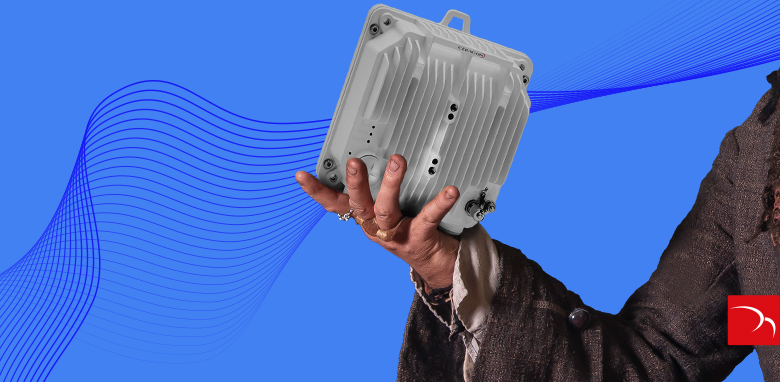Everyone loves a great new gadget. The intoxicating excitement of a new piece of tech that promises to change the way we work or revolutionize our potential to play. The world of wireless telecom technology has its share of shiny new toys. Some deliver on their “game-changing” promise, like Ceragon’s Disaggregated Open Routing (DOR) solution, while others burn bright and fast and then fizzle and fade into obscurity.
In recent years, a handful of microwave equipment providers unveiled what they call "Sub-Band Free" RF outdoor units, which aim to simplify the deployment and management of microwave networks across various frequency sub-bands. However, beneath the promise and potential lie some seriously significant obstacles, constraints, and complexities that have hindered any widespread adoption.
Diplexer – The Fun-to-Say Single frequency filter
Modern digital radios rely on bandpass radio frequency filters to prevent signal interference within the receiver chain. These filters, often termed diplexers, possess a passband capable of accommodating multiple radio channels. The specific number of channels can vary depending on factors such as the frequency band, transmit-receive spacing, and channel bandwidth. Higher frequency bands boast broader diplexers, while lower bands need to negotiate narrower ones, limiting the potential for software-driven adjustments.
Tunable Transceivers
Sub-band free radios introduce a revolutionary concept: the ability to fine-tune the transceiver's range, typically spanning a half-band (either low or high). This tuning process is achieved through diplexers that can be remotely adjusted via software control. Current solutions often employ mechanical mechanisms that manipulate a moving dielectric plate within each branch of the diplexer assembly driven by a stepping motor. Consequently, these tunable radios are bulkier, weightier, and pricier in comparison to their non-tunable counterparts.
But, the downside of tunable diplexers goes far beyond the added size, weight, and cost of the devices. Sub-band free radios can only provide tuning flexibility at higher frequencies, such as 18GHz, where a very limited number of sub-bands exist.
Things only get worse from there because sub-band free radios do not support any of the lower frequencies. That’s important because there are dozens and dozens of sub-bands in the 6GHz range alone that are not accessible with sub-band free radios, rendering their purported added ‘flexibility’ useless.
Ceragon Does Diplexers Differently
Ceragon’s innovative approach eliminates diplexers from the transceiver unit, housing them in a separate diplexer unit positioned between the Outdoor Unit (ODU) and the antenna. It’s the literal embodiment of thinking ‘out-of-the-box’ and makes it possible to accommodate even lower frequency bands, such as 6GHz, alleviating supply chain dilemmas and enabling adaptable forecasting, procurement, and management of diplexers independently from the radio units. The outcome? Reduced dimensions, lighter weight, lower costs, simplified mechanical architecture, and far greater flexibility when it comes to accessing lower-range sub-band frequencies.
‘Sub-Band Free’ Considerations and Constraints
Apart from their noticeable increase in size, weight, and cost, sub-band free radios employing tunable diplexers come with some not-so-obvious obstacles:
- Frequency Confinement:
These radios typically offer support only within a predefined set of frequency bands, generally ranging from 13GHz to 23GHz, with specific transmit-receive spacings.
- Restricted RF Performance:
Sub-band free radios that don’t offer separate, independent diplexer assemblies often exhibit standard or limited RF performance levels. This can lead to additional losses in Transmit Power and Receiver Threshold, rendering them unsuitable for longer transmission hops and necessitating larger antennas.
- Diminished Reliability and MTBF:
Mechanically tunable mechanisms in sub-band free radios may experience a decline in Mean Time Between Failures (MTBF). These mechanisms introduce moving parts driven by stepper motors, potentially causing deployment complications and impeding the ability to retune units to the correct configuration.
Despite their presence in the market for several years, sub-band free radios have struggled to achieve widespread adoption within the microwave industry. This reluctance is grounded in various factors, including their limited RF performance, which may necessitate larger antennas for specific applications, and their confined frequency band coverage. Furthermore, considerations like modulation support, channel bandwidth limitations, IF cable length requirements, and other nuances may further complicate their introduction, potentially raising operational expenses and inflating the Total Cost of Ownership (TCO). Thus, network operators are encouraged to carefully consider tunable radios and weigh the trade-offs before committing to broad-scale deployment.
In situations where operators want the flexibility a tunable radio can provide but don’t want to bear the additional cost and size burden of a dedicated Sub-Band Free radio, external diplexer units like the ones offered by Ceragon are a great alternative.
Looking to learn more about advanced wireless technology that delivers on the promise of flexibility and freedom? Check out Ceragon’s Disaggregated Open Routing (DOR) solution


